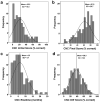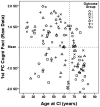Factors affecting open-set word recognition in adults with cochlear implants
- PMID: 23348845
- PMCID: PMC3636188
- DOI: 10.1097/AUD.0b013e3182741aa7
Factors affecting open-set word recognition in adults with cochlear implants
Abstract
Objective: A great deal of variability exists in the speech-recognition abilities of postlingually deaf adult cochlear implant (CI) recipients. A number of previous studies have shown that duration of deafness is a primary factor affecting CI outcomes; however, there is little agreement regarding other factors that may affect performance. The objective of the present study was to determine the source of variability in CI outcomes by examining three main factors, biographic/audiologic information, electrode position within the cochlea, and cognitive abilities in a group of newly implanted CI recipients.
Design: Participants were 114 postlingually deaf adults with either the Cochlear or Advanced Bionics CI systems. Biographic/audiologic information, aided sentence-recognition scores, a high resolution temporal bone CT scan and cognitive measures were obtained before implantation. Monosyllabic word recognition scores were obtained during numerous test intervals from 2 weeks to 2 years after initial activation of the CI. Electrode position within the cochlea was determined by three-dimensional reconstruction of pre- and postimplant CT scans. Participants' word scores over 2 years were fit with a logistic curve to predict word score as a function of time and to highlight 4-word recognition metrics (CNC initial score, CNC final score, rise time to 90% of CNC final score, and CNC difference score).
Results: Participants were divided into six outcome groups based on the percentile ranking of their CNC final score, that is, participants in the bottom 10% were in group 1; those in the top 10% were in group 6. Across outcome groups, significant relationships from low to high performance were identified. Biographic/audiologic factors of age at implantation, duration of hearing loss, duration of hearing aid use, and duration of severe-to-profound hearing loss were significantly and inversely related to performance as were frequency modulated tone, sound-field threshold levels obtained with the CI. That is, the higher-performing outcome groups were younger in age at the time of implantation, had shorter duration of severe-to-profound hearing loss, and had lower CI sound-field threshold levels. Significant inverse relationships across outcome groups were also observed for electrode position, specifically the percentage of electrodes in scala vestibuli as opposed to scala tympani and depth of insertion of the electrode array. In addition, positioning of electrode arrays closer to the modiolar wall was positively correlated with outcome. Cognitive ability was significantly and positively related to outcome; however, age at implantation and cognition were highly correlated. After controlling for age, cognition was no longer a factor affecting outcomes.
Conclusion: There are a number of factors that limit CI outcomes. They can act singularly or collectively to restrict an individual's performance and to varying degrees. The highest performing CI recipients are those with the least number of limiting factors. Knowledge of when and how these factors affect performance can favorably influence counseling, device fitting, and rehabilitation for individual patients and can contribute to improved device design and application.
Figures












References
-
- Anderson MJ. A new method for non-parametric multivariate analysis of variance. Austral Ecology. 2001;26:32–46.
-
- Armitage S. An analysis of certain psychological tests used for the evaluation of brain injury. Psychology Monographs. 1946;60 (#277)
-
- Aschendorff A, Kromeier J, Klenzner T, et al. Quality control after insertion of the Nucleus Contour and Contour Advance electrode in adults. Ear Hear. 2007;28:75S–79S. - PubMed
-
- Battmer R-D, Gupta SP, Allum-Mecklenburg DJ, et al. Factors influencing cochlear implant perceptual performance in 132 adults. Ann Otol Rhinol Laryngol, suppl. 1995;166:185–187. - PubMed
-
- Blamey P, Arndt P, Bergeron F, et al. Factors affecting auditory performance of postlinguistically deaf adults using cochlear implants. Audiol Neurootol. 1996;1:293–306. - PubMed
Reference Notes
-
- Geers A, Davidson L, Uchanski R. Segmental and indexical perception following early cochlear implantation. Paper presented at the American Auditory Society Annual Meeting; Scottsdale, Arizona. 2012.
Publication types
MeSH terms
Grants and funding
LinkOut - more resources
Full Text Sources
Other Literature Sources
Medical

